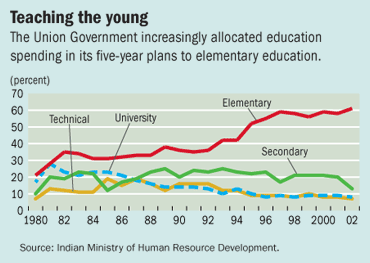I came across these two articles on the education of Muslim children in India. First one talks about the % of Muslim children educated in madrassah's being only 4%. The fact that the children are being educated in a madrassah is not the problem. Why would religious education be a problem when Christian Covent education or Hindu Ekal Vidyalaya education isn't?
The challenge that comes is from the lack of modern subjects in the madrassah curriculum but that will take much longer to overcome. Where are you going to get the teachers from? These are tiny schools in tiny villages and places where there is no public schools. If you have a graduate who has knowledge of science, mathematics, arts, etc. etc., you need to wonder why on earth would he become a teacher there?
So the economics are not right and that is why you have the problem of ghost schools or no attendance at government schools as well. But as long as you dont have howling bigots emerging from these religious schools, that's fine, nothing wrong with providing a religious and moral education to the young chaps.
The second article talks about the % of Muslim children enrolled in primary classes (presumably public government schools). I quote:
During 2006-07, only 9.38% Muslims were enrolled in primary classes in the country and only 7.62% at upper primary level.
Best case scenario? that 9.38%+4% means 13.38% of Muslim children are getting some kind of education. If there is a worst case scenario, then all the children who go to a madrassah also go to a public school, then the % is 9.38%. If I compare this to the overall net enrolments rate (and yes, I realise that there is a heroic assumption behind this that the 2 numbers are the same, all I am referring to is that they are similar!), we get to a net figure of 92% for males and 87% for females for 200-2005. So, if I am not totally missing the plot, there is a gigantic difference between the national figures and the Muslim Children figures. (Incidentally, here's a good overview of our education system, see the copied table at the bottom).
Well, there is no debate about what needs to be done, and frankly, the last thing you need to do is to create a separate government funded religious school system, that will simply store up trouble in the religiously sensitive state. So you improve the public school system. Here's a fascinating overview of what can be done to improve, and what did not work.
Stop looking at them as Muslim poor or uneducated. Look at them as Indian uneducated. Every Indian who is uneducated is a blot on India, not on Indian Muslims. Indian Hindu's share the blot just like Indian Females or Indian Tamils. Let us not go down the religious route on this frankly delicate matter but lets select the Indian districts which have the worst educational performance and improve them, move from bottom up. That way, ALL poor and uneducated Indians will improve, you will avoid sectarianism and religious strife and India will benefit. By all means, keep tracking the progress of the Muslim kids, but the government efforts should be religious neutral. Let civil society take care of their religious education while the Government look after all citizens.
Here's another view of how to address this. Here's a good link to a scheme which shows the link between education and diet. Dont look to the government for everything even though it is trying its level best (see here), here's how NGO's and local society have gotten together to develop local schooling.
Money is being spend on the children as the graph below shows but I am still wondering why that huge difference is for National numbers and Muslim student numbers. Money is being spent, improvement is happening across the board, where is the problem?

Educating the masses
After primary education was made a national priority, enrollment—especially for girls—showed dramatic gains.
| | 1993 | 2002 |
| (percent) | ||
| Primary education (grades 1-5 for ages 6-11) Total gross enrollment ratios1 Among boys Among girls Upper primary education (grades 6-8 for ages 11-14) Total gross enrollment ratios Among boys Among girls Secondary education (grades 9-12 for ages 15-18) Total gross enrollment ratios Among boys Among girls Tertiary education (postsecondary to postgraduate for ages 19-24) Total gross enrollment ratios Among boys Among girls | 82 90 73 54 62 45 32 39 24 5.3 6.8 3.6 | 95 98 93 61 65 56 36 39 30 9 10.3 7.5 |
| (percent of GDP) | ||
| Total public spending on education and training Total public spending on elementary education and training | 3.6 1.7 | 4.1 2.1 |
| (dollars) | ||
| Public spending per elementary student (constant 2002 prices) | 25 | 44 |
Sources: Data from India´s Ministries of Human Resource Development and Finance; and World Bank estimates.
1Gross enrollment is the ratio of the number of children enrolled in primary education, regardless of age, to the population of the age group that corresponds to the nationally defined ages for primary schooling. A gross enrollment ratio in excess of 100 percent typically reflects the inclusion of underage as well as overage students who have entered school late or repeated grades.
No comments:
Post a Comment